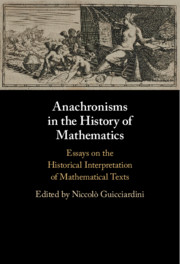 Anachronisms in the History of Mathematics
Anachronisms in the History of Mathematics Published online by Cambridge University Press: 19 July 2021
Historians are constantly confronted with the twin problems of translating texts and interpreting their meanings. When mathematicians like Georg Cantor or Abraham Robinson demonstrate the consistency of concepts that, since the paradoxes of Zeno and Democritus, have been assumed to be paradoxical notions like infinitesimals or the actual infinite, how should the works of earlier mathematicians be regarded, who either used such concepts or believed they had proven their impossibility? Is it anachronistic to use nonstandard analysis or transfinite numbers to “rehabilitate” or explain the works of Leibniz, Euler, Cauchy, or Peirce, for example, as recent mathematicians, historians, and philosophers of mathematics have attempted? At the other extreme, chronologically, how may ideas readily accepted in the West – like incommensurable numbers, parallel lines, and similar triangles – but foreign to traditional Chinese mathematics have adversely affected the interpretations of ancient Chinese mathematical works?
To save this book to your Kindle, first ensure [email protected] is added to your Approved Personal Document E-mail List under your Personal Document Settings on the Manage Your Content and Devices page of your Amazon account. Then enter the ‘name’ part of your Kindle email address below. Find out more about saving to your Kindle.
Note you can select to save to either the @free.kindle.com or @kindle.com variations. ‘@free.kindle.com’ emails are free but can only be saved to your device when it is connected to wi-fi. ‘@kindle.com’ emails can be delivered even when you are not connected to wi-fi, but note that service fees apply.
Find out more about the Kindle Personal Document Service.
To save content items to your account, please confirm that you agree to abide by our usage policies. If this is the first time you use this feature, you will be asked to authorise Cambridge Core to connect with your account. Find out more about saving content to Dropbox.
To save content items to your account, please confirm that you agree to abide by our usage policies. If this is the first time you use this feature, you will be asked to authorise Cambridge Core to connect with your account. Find out more about saving content to Google Drive.